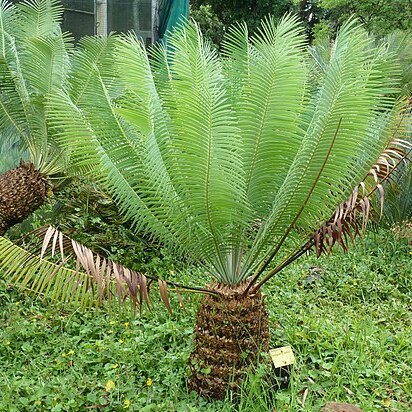Plant freely branched from base; stems up to about 3 m long and often spreading or reclining at this stage, 17-23 cm diam. (including the persistent leaf bases); bracts lanceolate, about 4-5 cm long, tomentose. Leaves 0.8-1-2 m long including petiole 10-20 cm long; rhachis nearly straight, sometimes slightly up-curved and twisted towards apex, glabrous except for woolly back of pulvinus, flat or ridged on upper surface towards base, rounded on under surface, 8-13 mm thick; pulvinus up to 3.5 cm long, 4.5 cm broad, with dense brown wool on back readily nibbed off, shrinking in size and wearing down considerably with age to about 1.5-2 cm long; leaflets glabrous, glaucous on under surface when young, becoming green with age, base or foot inserted parallel to axis, usually pungent, with entire margin or occasionally with 1-2 minute teeth on the lower margin near and directed towards the apex, those leaflets above middle of leaf directed slightly upwards and outwards and sometimes recurving, not overlapping, reduced in size near apex of rhachis, those about the middle spreading more or less at right angles from rhachis, those below directed slightly downwards and slightly falcate, 1-2 cm distant from each other and reduced in size rather abruptly to 2-6 prickles on either side of the rhachis; median leaflets linear-attenuate, 14-21 cm long, 8-13 mm broad in the lowest 1/3 and from there gradually tapering to the slender pungent apex, only slightly narrowed at base, not very rigid, with 13-21 veins evident but not raised on the lower surface. Male cones 2 or more together (immature) on peduncles about 5 cm long and 1.5 cm thick, 8-10 cm long, 4-4.5 cm diam.; scales dense (few showing some dehiscene) about 2 cm long (tips all damaged) 1.7-2 cm broad, with acute lateral margin, maximum vertical thickness 5 mm; microsporangia dense on lower basal half; beak projecting about 1 cm. with upper facet humped in middle, lower facet nearly flat, glabrous round base of beak, shortly greyish scurfy-pubescent towards apex. Female cones not yet recorded.
Plant freely branched from base. Stems up to 3 m long. Leaves up to 1.5 m long, bluish green. Leaflets towards base of petiole deflexed in relation to rhachis, basal leaflets reduced to a short or long series of prickles, median leaflets 140-210 x 8-13 mm, 13-21-veined on undersurface.


